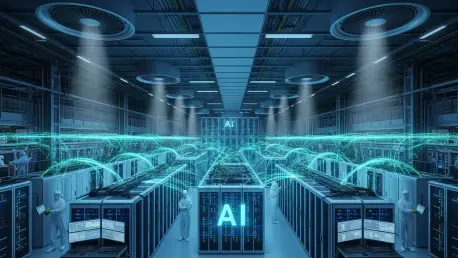The AI Industry Landscape: Setting the Stage
The artificial intelligence sector stands as a powerhouse of modern innovation, with global investments soaring into the hundreds of billions annually, reshaping economies and redefining technological boundaries. This rapid ascent has positioned AI not just as a tool but as a cornerstone of industries ranging from healthcare to finance, driving efficiency and unlocking new capabilities. The sheer pace of growth underscores a critical need for robust infrastructure to support increasingly complex models and applications, setting the stage for transformative shifts across the board.
At the heart of this ecosystem lie distinct segments such as AI research, infrastructure development, and practical applications like chatbots, with tools like Anthropic’s Claude gaining widespread adoption. Major players, including Anthropic, OpenAI, and hyperscalers like Amazon Web Services and Google Cloud, dominate the competitive landscape, each vying for supremacy through innovation and scale. These entities not only shape market trends but also influence how quickly new AI solutions reach businesses and consumers, intensifying the race for technological leadership.
Technological advancements, particularly in GPU capabilities and cloud computing, fuel this dynamic field, enabling the processing power necessary for frontier AI models. Meanwhile, regulatory pressures and societal expectations add layers of complexity, as governments grapple with balancing innovation against ethical and security concerns. These external forces, combined with public scrutiny, ensure that the trajectory of AI remains both promising and precarious, demanding strategic foresight from industry leaders.
Anthropic’s Bold Move: Unpacking the $50B Investment
Driving Forces Behind the Data Center Push
Anthropic’s decision to channel $50 billion into constructing its own data centers marks a pivotal moment in the AI sector, driven by an unprecedented surge in demand for its services. With over 300,000 business customers and a nearly sevenfold increase in large accounts generating substantial revenue, the company faces pressure to scale operations rapidly. This investment reflects a strategic response to ensure that capacity keeps pace with the growing reliance on AI tools across diverse industries.
Beyond demand, the push for customized infrastructure is rooted in the need to optimize efficiency for cutting-edge AI models that require specialized computing environments. By building tailored facilities, Anthropic aims to enhance performance and reduce latency, addressing the unique workloads of its systems. This move also signals a broader industry shift toward vertical integration, as firms seek greater control over resources rather than depending on third-party providers for critical infrastructure.
The trend of moving away from reliance on external hyperscalers highlights a maturing market where securing sustainable access to computing power becomes a competitive edge. Industry experts note that owning infrastructure allows companies to mitigate risks associated with supply chain disruptions or capacity constraints. For Anthropic, this bold step is not just about meeting current needs but positioning itself as a leader in defining how AI infrastructure evolves over time.
Scale and Impact Projections
Specifics of Anthropic’s ambitious projects reveal plans for new data centers in strategic locations such as Texas and New York, poised to bolster regional tech hubs. These facilities are expected to generate significant economic benefits, including 800 permanent jobs and 2,400 temporary construction roles as they come online within the next year. Such outcomes underscore the tangible impact of AI investments on local communities, fostering employment and skill development.
Looking ahead, this initiative aligns closely with national goals to strengthen U.S. AI infrastructure, ensuring a competitive stance against global counterparts like China. The scale of this commitment could set a benchmark for domestic tech policy, encouraging further public-private collaboration to build resilient systems. Analysts predict that these centers will play a key role in supporting the next generation of AI advancements, from research to real-world deployment.
From a market perspective, Anthropic’s investment may reshape competitive dynamics, potentially inspiring other well-funded AI labs to pursue similar proprietary models. While many startups lack the capital to emulate this approach, the precedent could pressure existing players to rethink reliance on leased infrastructure. This shift might intensify the race for resources, redefining how companies balance cost, control, and innovation in their strategic planning.
Challenges of Scaling AI Infrastructure
The technological hurdles of constructing and managing data centers for AI workloads are formidable, given the immense energy and computational demands involved. These facilities must support supercomputers capable of handling vast datasets, often requiring cutting-edge hardware that pushes the limits of current engineering. Ensuring reliability and uptime amid such complexity presents a persistent challenge for companies aiming to scale rapidly.
Market-driven obstacles further complicate the landscape, as fierce competition for scarce resources like GPUs creates bottlenecks in supply chains. With multiple firms vying for the same hardware, delays and cost escalations can hinder project timelines, impacting the ability to meet rising demand. This scarcity underscores a critical pain point in the industry, where access to essential components often determines the pace of progress.
Sustainability concerns also loom large, as data centers consume significant amounts of electricity and water for cooling, placing burdens on local grids and resources. The environmental footprint of such operations raises questions about long-term viability, with potential cost increases affecting nearby communities. To address these issues, strategies like adopting renewable energy sources and exploring innovative cooling technologies are gaining traction, offering pathways to mitigate ecological and economic impacts.
Regulatory and Environmental Considerations
Navigating the regulatory landscape is a crucial aspect of expanding AI infrastructure, with U.S. policies such as the AI Action Plan shaping the framework for development. These guidelines prioritize national interests, emphasizing the need for robust systems to maintain global leadership while addressing security risks. Compliance with evolving standards around data handling and cybersecurity remains a top concern for companies managing sensitive AI workloads.
Environmental implications add another dimension to the discourse, as the high energy consumption of data centers draws scrutiny from policymakers and advocacy groups alike. The push for sustainable practices is intensifying, with mandates emerging to curb carbon footprints through green energy adoption and efficiency measures. Balancing these requirements with operational needs tests the adaptability of firms investing heavily in physical infrastructure.
As regulations continue to evolve, there is a growing focus on harmonizing innovation with societal and ecological priorities. Future policies may impose stricter guidelines on resource usage or incentivize eco-friendly designs, influencing how data centers are planned and operated. This dynamic environment necessitates proactive engagement from industry stakeholders to ensure that growth does not come at the expense of broader responsibilities.
Future Horizons: AI Infrastructure and Beyond
Anthropic’s data center strategy holds profound implications for the long-term trajectory of the AI sector, potentially redefining standards for scalability and efficiency. By establishing a model of ownership over critical infrastructure, the company could inspire a wave of similar investments, shifting the paradigm away from leased resources. This trend might accelerate the development of more autonomous and resilient AI ecosystems over the coming years.
Emerging technologies, such as advanced chip architectures and decentralized computing frameworks, stand to either complement or disrupt current infrastructure models. Innovations in hardware could reduce energy demands, while distributed systems might offer alternatives to centralized data centers, reshaping cost structures. Keeping pace with these advancements will be essential for companies to maintain relevance in an ever-evolving field.
Global competition, particularly between the U.S. and China, alongside shifting consumer preferences for AI tools, will likely drive future investment patterns. Economic conditions and the specter of an AI investment bubble also warrant caution, as overzealous funding without tangible returns could destabilize markets. Staying attuned to these factors, while fostering innovation, will determine how the industry navigates potential disruptors and capitalizes on untapped opportunities.
Conclusion: Weighing Promise Against Peril
Reflecting on Anthropic’s monumental $50 billion venture into data centers, the initiative stands as a testament to both ambition and uncertainty within the AI realm. It highlights a transformative opportunity to redefine infrastructure benchmarks, yet also exposes significant risks tied to sustainability and financial speculation. The dual nature of this endeavor captures the broader tension that characterizes the industry’s rapid evolution during this period.
For stakeholders, the path forward demands a commitment to sustainable practices, integrating renewable energy and efficient designs to lessen environmental strain. Prudent investment strategies also become critical to sidestep the pitfalls of a potential bubble, ensuring that capital flows into projects with proven outcomes. Collaboration between industry and regulators emerges as a vital step to align innovation with societal needs.
Looking beyond immediate challenges, attention turns to fostering resilient systems capable of adapting to technological and geopolitical shifts. Prioritizing research into energy-efficient computing and exploring decentralized models offers promising avenues to sustain growth. These considerations lay the groundwork for a future where AI’s potential can be harnessed responsibly, driving progress without compromising stability.









